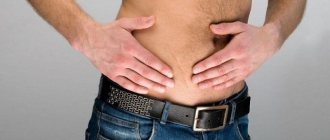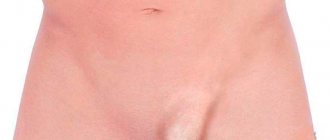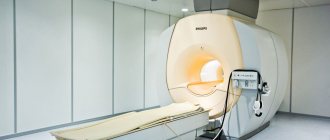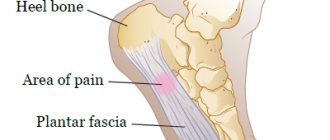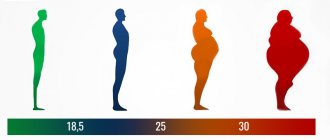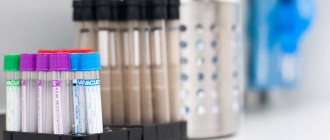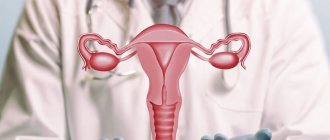In humans, the groin area is located at the junction of the lower abdomen with the thighs. Accordingly, the pain that occurs in the groin when walking is associated with problems of the organs located in this place. These are primarily the organs of the human genitourinary system. Their diseases are characterized by pain symptoms in the groin area, aggravated by movement. Establishing the true causes of pain in the groin area is the key to effective treatment of the disease. Unpleasant sensations in the groin area may indicate serious health problems.
Unilateral groin pain
Pain in the right groin may be a symptom of inflamed appendicitis. This will be indicated by increased pain when:
- palpation in the right groin area,
- position on the right side,
- raising your left leg up,
- coughing and defecation.
An attack of appendicitis may be accompanied by a feeling of nausea, vomiting and fever.
Groin pain is not such a rare occurrence. Here a person has organs of the urinary and reproductive systems, nerve fibers, lymph nodes, muscles, etc. What to do if your groin hurts? We will tell you in this article.
Pain in the left groin may be a symptom of renal colic or hernia. Such a hernia is called an inguinal hernia and occurs when part of the intestines protrudes in the groin area as a result of weakening of the muscles of the abdominal wall. Compression of the hernial sac causes sharp and intense pain. Don't delay seeking medical help.
Renal colic provokes an acute attack of pain in the lumbar region, radiating to the groin, leg and bladder. The cause of pain is a stone that irritates the ureteral mucosa. To quickly stop an attack and get rid of pain, go to the hospital immediately. A special procedure may be needed to break the stone into smaller pieces.
Diagnostics
Women, as a rule, turn to a gynecologist. If necessary, a dermatologist, urologist, and surgeon take part in the examination. During the conversation, the circumstances under which the symptom first arose are established, the dynamics of its development, and its connection with various factors are examined. As part of a general examination, local purulent foci and signs of damage to the gastrointestinal tract, urinary tract and musculoskeletal system are identified.
For folliculitis, dermatoscopy is performed. In patients with local infectious processes, purulent discharge is collected. To clarify the diagnosis, the following procedures are prescribed:
- Gynecological examination.
It is carried out to identify inflammatory and non-inflammatory diseases, tumors of the genital organs. The condition of the vulva, vagina, uterus and appendages is examined, signs of emergency conditions are determined, discharge is taken, and sometimes tissue samples are taken for morphological examination. - Ultrasonography.
Ultrasound of the pelvic organs is informative for gynecological pathologies and CPPS. Ultrasound of the abdominal organs is prescribed for damage to the gastrointestinal tract. For patients with suspected urolithiasis and other urinary tract diseases, ultrasound of the kidneys and ureters and ultrasound of the bladder are recommended. - Radiography.
To examine the condition of the uterus and appendages, hysterosalpingoscopy is performed. Women with diseases of the kidneys, ureters and bladder are referred for excretory urography or cystography. For some diseases of the digestive system, irrigoscopy is performed. Patients with injuries and orthopedic diseases are prescribed x-rays of the hip joint. - Endoscopic studies.
Taking into account the presumed localization of pathological changes that provoke pain, women can undergo hysteroscopy, cystoscopy, urethroscopy and colonoscopy. If acute appendicitis is suspected and other diagnostic procedures are insufficiently informative, laparoscopy is performed. - Lab tests.
The list may include general blood and urine tests; PCR tests to exclude STIs; microscopy of urogenital smear; bacterioscopy of discharge from the genital tract and purulent discharge from skin lesions; cytological examination of smears to identify atypical cells; histological analysis of a biopsy of the lymph node, genitals, anus or urinary tract; stool occult blood test.
Causes of groin pain in women
Pain in the lower abdomen in the groin in women is most often a symptom of so-called female diseases. Diseases of the reproductive system often occur against a background of general malaise and elevated body temperature. Palpation of the abdomen causes pain.
Pain in the lower groin, caused by an ovarian cyst, is characterized as dull and drawing. They can appear on both the left and right sides. But if the cyst has twisted or burst, the pain becomes acute. Chills and vomiting may occur.
Acute pain in the groin in women can be one of the symptoms of ectopic pregnancy. When an embryo grows in a tube, it presses on the walls throughout its growth, which causes dull periodic pain. If the fallopian tube ruptures, the pain becomes sharp and sharp. This is a wake-up call! It is accompanied by severe internal bleeding and can lead to serious consequences (drop in blood pressure, shock, anemia, etc.).
Pain in the lower groin in women, which accompanies the onset of menstruation, is nagging, aching, gradually increasing and subsiding. It usually goes away after the onset of menstruation.
Pain in the right groin in a woman can be caused by inflammation of the appendicitis, fallopian tube (salpingitis), ovary (oophoritis) and ureter (ureteritis).
Types of pain
Painful manifestations in the pelvis and groin area can vary in severity and course. The pain can be bright and sudden, and sometimes with a long period of growth.
Acute
Usually the pain is short-term, the patient is easily able to determine its location. The appearance of acute pain indicates organic damage or the formation of a disease.
At first, pain occurs in a specific place, and over time it dissipates throughout the body.
Aching
This type of pain usually appears against the background of acute pain manifestations, but covers a larger area.
Painful sensations most often increase and disappear, and after a while they appear again. It is quite difficult to determine the location of pain, which makes therapy difficult.
Chronic
This type of pain can last for more than six months. This symptom is very difficult to identify and treat. Often, to get rid of painful manifestations of a chronic nature, surgery is required.
If pain in the pelvic and groin areas of any nature systematically appears during even minor physical activity, you should immediately consult a doctor. You should not treat yourself, as the disease in its advanced form can cause serious health problems, which will require serious and long-term treatment.
Causes of pain in men
Pain in the groin in the lower abdomen in men can cause diseases associated primarily with the human reproductive system. Constant weak, aching pain in the groin in men can be one of the symptoms of diseases of the testicles and their appendages, prostate or benign adenoma.
With inflamed epididymis, pain increases while walking. Inflammation of the prostate gland is characterized by pain of a wide variety of types. They can be sharp, stabbing, aching, often chronic in nature - since many patients do not seek medical help due to fear.
These are the most common reasons why men have groin pain.
Strong excitement
Another reason could be severe overexcitation, after which there was no ejaculation. Due to the fact that the seminal fluid is not released, a strong spasm occurs, manifested by pain. Fullness of the testicles causes unpleasant symptoms. But the pain here is not sharp, but aching and pulling.
The physiological nature of the symptom, which does not require urgent medical attention, is indicated by the following signs:
- the pain is nagging, moderate and not accompanied by general malaise or fever;
- there are no rashes, redness, or swelling on the skin of the scrotum;
- the process of urination is not disturbed, the color of urine is not changed.
Other causes of groin pain
If you have pain in the groin area, pay attention to the condition of the lymph nodes, femoral arteries, intestines, etc. The inflamed lymph node usually becomes denser and increases in size. The pain is localized around the inflamed node, and its intensity depends on the stage of inflammation.
Intestinal diseases, in addition to pain, can be accompanied by: stool disturbances, accumulation of gases, the urge to defecate when the intestines are empty, etc. These disorders may accompany pain in the groin on the right and left. Such diseases include intestinal infections, poisoning, intestinal obstruction (the pain will be of a cramping nature).
Sometimes the cause of pain may not be only a disease. In people who exercise intensely, pain occurs due to a sprained ligament or muscle injury. Typically, such pain is characterized as aching (trauma) or sharp (sprain).
What to do if your leg hurts in the groin? The reason for this may be radiating pain. This is the one that is transmitted to an area distant from its source. In this case, you need to look for the root cause. For example, with osteochondrosis, the source of pain is localized in the lower back. Due to a pinched nerve, pain may radiate to the groin area.
Another cause of pain may be inflammatory and degenerative processes in the hip joint. These are various types of arthritis, arthrosis and damage to joint tissue by their immune cells. The disease is characterized by constant pain in the joint, which intensifies during movement.
What to do for groin pain
If you have pain in the groin, first of all, diagnosis is important:
- Pay attention to which side it hurts and where it radiates.
- Determine the nature and intensity of pain.
- Pay attention to the frequency of the urge to urinate or defecate.
- Measure your body temperature (the inflammatory process will be accompanied by an increase in temperature).
- Pay attention to your general health, the presence of nausea.
- Measure your blood pressure.
- If you're an athlete, reconsider your workout intensity.
- If you are a woman, pay attention to the timing and nature of your period.
- Be sure to visit a doctor if pain persists.
Remember, sharp pain in the groin is a reason to immediately visit a doctor. Such pain is unlikely to go away on its own.
Nagging pain in the groin in women should prompt you to visit a gynecologist.
Pain in the left groin may indicate a hernia, a pinched nerve in the lower back, inflamed lymph nodes or problems with the intestines; it is worth visiting a therapist.
How to relieve pain
It is not always possible to see a doctor right away if your lower back hurts and radiates to the groin. Sometimes you have to look for a temporary solution to relieve pain in the lower body before visiting the clinic. Taking antispasmodics, which include no-spa and papaverine, can help. If you need to bring down the temperature, you can take Ibuprofen or Nurofen, but if the temperature is below 38 degrees, it is not recommended to bring it down. Under no circumstances should you heat or cool a sore spot without a doctor’s instructions. It is also worth providing the patient with bed rest.
Treatment of groin pain
Diseases of the genitourinary system require adherence to a gentle diet in order to relieve the body a little and help it direct all its strength to fight the pathology. As a rule, the consumption of fatty, spicy and fried foods is limited. There is also a ban on the consumption of alcoholic beverages, coffee, and sweet carbonated water. Lean meat and fish are allowed (in limited quantities), lots of vegetables and fruits. It is recommended to cook food using steam. Break your meals into 5-6 small portions. All this will alleviate the symptoms of the disease.
For pain caused by bloating, eliminate dairy products, flour products (especially white flour), beans and cabbage from your diet.
For muscle pain, limit the load on the area of the injured muscle, provide it with rest and perform massage movements.
If you are prone to urolithiasis, drink a lot. Water reduces the concentration of uric acid and salts in the urine. Drink up to 10 glasses per day.
Remember that proper nutrition can solve and prevent many problems.
Which doctor should I contact if my testicle hurts?
If you encounter such a symptom, you need to contact a urologist or andrologist. The competence of these specialists includes the diagnosis and treatment of diseases of the genitourinary and reproductive systems. At the clinic Dr. AkNer employs specialists with extensive experience, and also has all the necessary equipment for a complete examination. Already at the initial consultation you will understand the tactics of diagnosis and subsequent treatment. To make an appointment, write to us in the online form or call our contact numbers at a convenient time.


